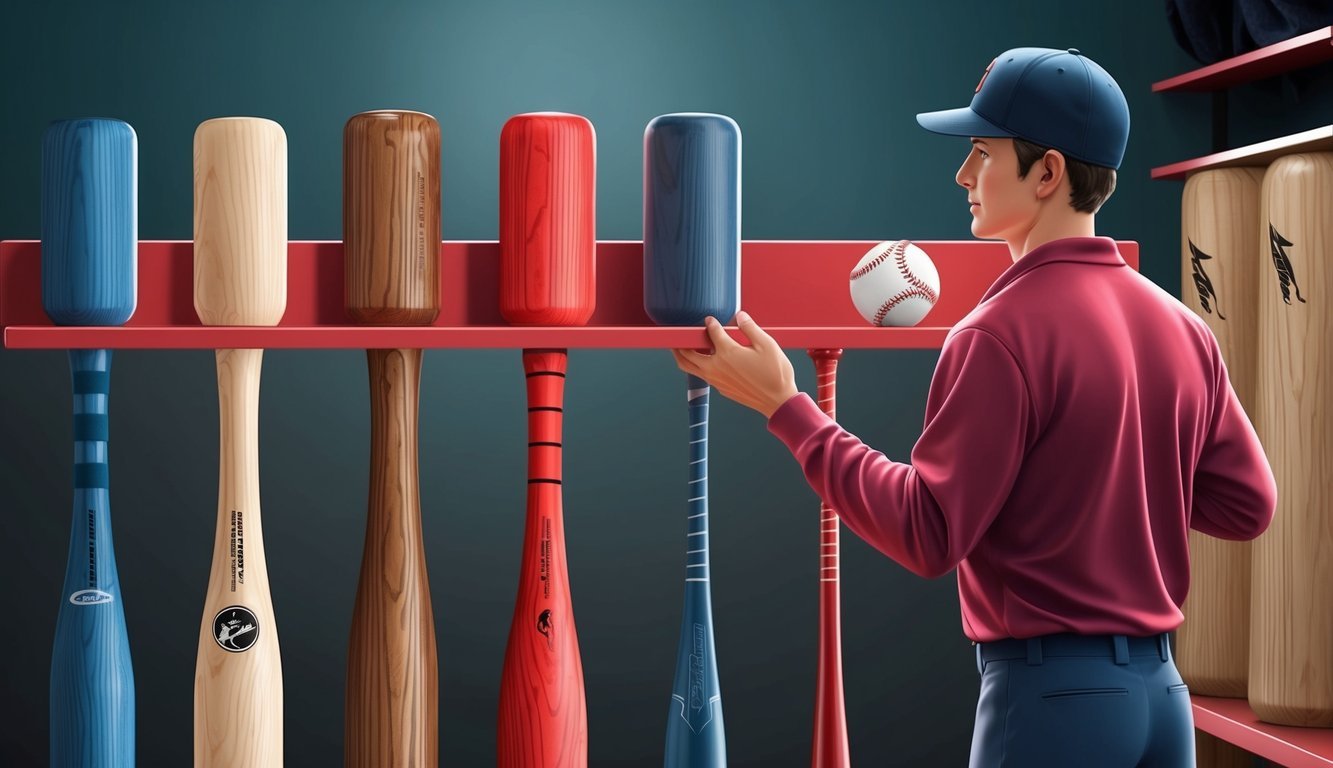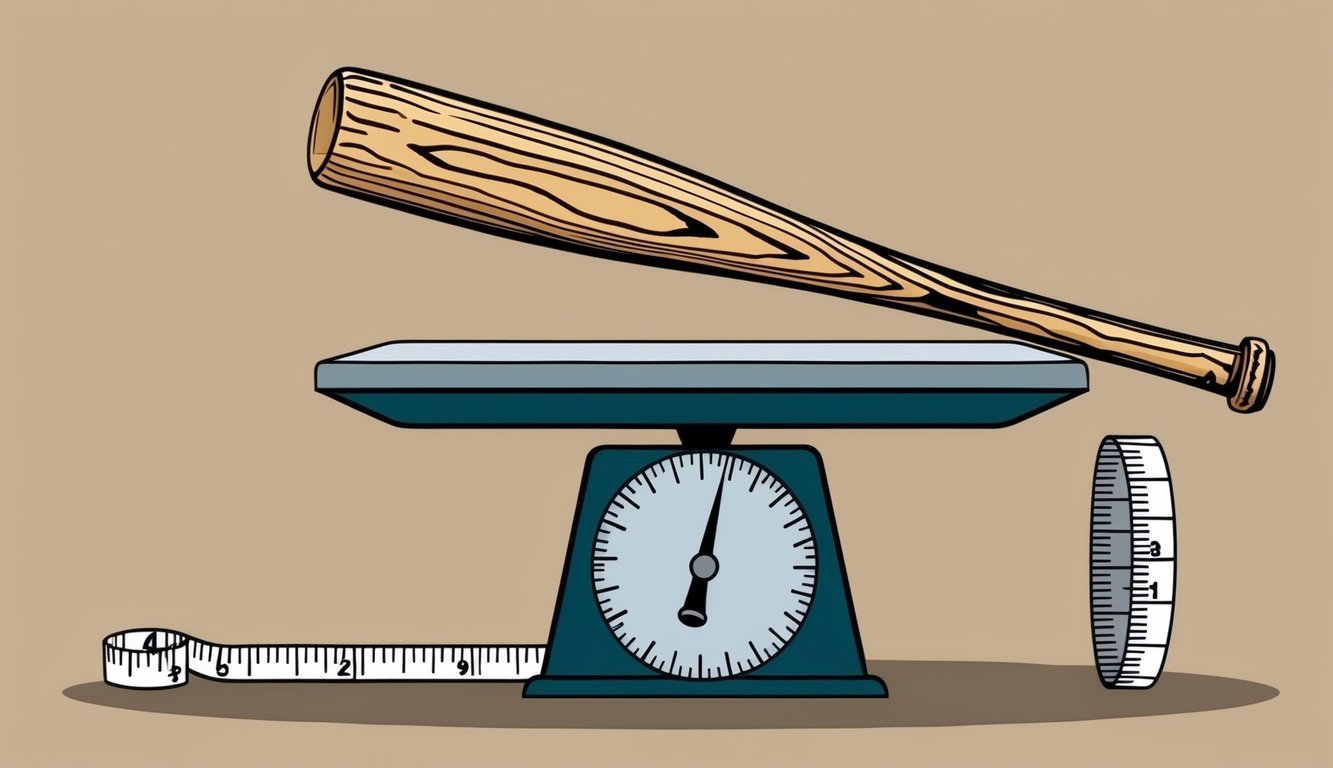Baseball bats come in various weights, each offering unique advantages to players.
The weight of a bat affects swing speed, control, and power at the plate. Most baseball bats used in competitive play weigh between 26 and 36 ounces.
Choosing the right bat weight is crucial for optimal performance.
Younger players typically use lighter bats to develop proper swing mechanics and build confidence.
As players grow stronger and more skilled, they often transition to heavier bats for increased power.
Bat weight also influences a player’s ability to make contact with the ball.
A lighter bat allows for quicker swings, potentially improving timing and bat speed.
Meanwhile, heavier bats can generate more force on contact, leading to longer hits when a player connects solidly with the ball.
Understanding Bat Weight and Length
Selecting the right bat weight and length is crucial for a player’s performance and comfort at the plate.
These factors impact swing speed, control, and power potential for hitters of all ages and skill levels.
Significance of Bat Weight and Length
Bat weight affects a player’s swing speed and control.
Lighter bats allow for quicker swings but may sacrifice power.
Meanwhile, heavier bats can generate more force but may slow down swing speed.
The ideal weight depends on the player’s strength and hitting style.
Length impacts a batter’s reach and coverage of the strike zone.
A bat that’s too long can feel unwieldy and slow down the swing.
Meanwhile, one that’s too short may limit plate coverage.
Players often use the “weight drop” to find their ideal bat.
This is the difference between the bat’s length in inches and weight in ounces.
For example, a 30-inch, 20-ounce bat has a -10 weight drop.
Standard Lengths and Weights by Age Group
Youth players typically use lighter bats with higher weight drops.
As players grow and advance to higher levels, they transition to heavier bats with lower weight drops.
For Little League (ages 7-12):
- Lengths: 26-32 inches
- Weight drops: -10 to -13
Babe Ruth League / Teen players (13-15):
- Lengths: 31-33 inches
- Weight drops: -5 to -8
High school and college players:
- Lengths: 32-34 inches
- Weight drops: -3 to -5
Bat size charts often use a player’s height and weight to suggest appropriate bat lengths.
For instance, a player under 60 inches tall might use a 26-29 inch bat, while someone 71-80 inches tall could opt for a 28-31 inch bat.
Materials and Bat Types
Baseball bats come in various materials, each offering unique characteristics that affect performance, durability, and feel.
The choice of bat material can significantly impact a player’s hitting experience and success at the plate.
Wood Bats vs. Alloy and Composite Bats
Wood bats are the traditional choice, crafted from ash, maple, or birch.
They offer a classic feel and are mandatory in professional leagues.
Meanwhile, alloy bats, made from aluminum or other metal alloys, provide durability and a larger sweet spot.
Composite bats use carbon fiber materials, offering a lighter swing weight and increased power potential.
These modern options are popular in youth and amateur leagues due to their performance benefits.
Each type has its place in the game, with wood bats favored for their authenticity and alloy and composite bats praised for their technological advancements.
Advantages and Disadvantages of Different Materials
Wood bats deliver a pure hitting experience but are prone to breaking.
Ash bats offer flexibility, while maple provides density and hardness for increased power.
Meanwhile, birch combines durability with flex.
Alloy bats are known for their immediate “pop” out of the wrapper and longevity.
They perform well in cold weather but may dent over time.
On the other hand, composite bats have a larger sweet spot and reduce vibration on mishits.
However, they require a break-in period and can be sensitive to temperature extremes.
Some leagues restrict certain bat materials, so players should check regulations before making a purchase.
Technical Aspects of Baseball Bats

Baseball bat design involves intricate engineering to optimize performance.
The weight and construction of a bat significantly influence a player’s swing mechanics and hitting power.
Bat Construction and Engineering
Baseball bats are marvels of sports engineering.
The barrel, handle, knob, and end cap each play crucial roles in a bat’s performance.
Most modern bats feature a large sweet spot in the barrel for optimal ball contact.
Engineers carefully balance the bat’s mass distribution to enhance control and power.
BBCOR and USSSA standards regulate bat performance in different leagues.
These standards ensure fair play and player safety.
Manufacturers use various materials like wood, aluminum, and composite to craft bats with different characteristics.
Composite bats often provide a larger sweet spot and reduced vibration.
The Impact of Bat Weight on Swing Speed
Bat weight directly affects swing speed and control.
Lighter bats allow for faster swings, potentially increasing bat speed and contact rate.
Meanwhile, heavier bats can generate more power but may slow down swing speed.
Players must find the right balance for their strength and hitting style.
Swing weight, which measures how heavy a bat feels during a swing, is often more important than the actual weight.
End-loaded bats have more mass in the barrel, while balanced bats distribute weight more evenly.
Many players use weighted donuts or bat sleeves during warm-ups to improve muscle memory and increase bat speed during games.
Choosing the Right Bat

Selecting the perfect baseball bat involves considering factors like weight, length, and balance.
These elements greatly impact a player’s swing and overall performance at the plate.
How to Select the Proper Bat Based on Skill Level
Beginners often benefit from lighter bats with a larger sweet spot.
This helps build confidence and improves bat control.
A -10 to -13 drop weight is common for young players.
Intermediate players can handle slightly heavier bats.
They might opt for a -7 to -9 drop, which offers a good balance of power and control.
Advanced players typically use heavier bats with smaller drops (-3 to -5).
These provide more power but require greater strength and skill to manage effectively.
It’s crucial to consider personal preference and comfort.
Players should swing various bats to find what feels best for their hitting style.
Additionally, understanding the one piece bat advantages can help players make an informed choice; these bats typically offer better energy transfer and a more solid feel upon contact.
This solid construction can enhance swing speed and provide greater consistency, making them a popular option among many hitters.
Ultimately, selecting the right bat can significantly impact overall performance on the field.
Weight Distribution and Its Effect on Batting
Bat weight distribution plays a key role in swing mechanics and power generation.
End-loaded bats concentrate more weight in the barrel, offering increased power for strong hitters.
Balanced bats distribute weight evenly, providing better control and faster swing speeds.
They’re ideal for contact hitters and those working on their form.
Players should consider their strength, hitting style, and skill level when choosing between end-loaded and balanced bats.
Barrel diameter also affects weight distribution.
Larger barrels offer a bigger sweet spot but may slow swing speed.
Meanwhile, smaller barrels allow for quicker swings but require more precise contact.
Try different options to find the right balance of power and control for your game.
Regulations and Standards

Baseball bat regulations ensure fair play and player safety across different leagues and age groups.
Specific rules govern bat dimensions, materials, and performance standards.
Understanding League Rules and Regulations
Major League Baseball requires bats to be no more than 42 inches long and 2.61 inches in diameter at the thickest part.
They must be made from a single piece of solid wood.
For youth leagues, USA Baseball introduced new standards in 2018.
These rules allow metal, wood, or composite bats but with specific size and weight restrictions.
For example, in 12U leagues, bats can’t exceed 34 inches in length.
Little League and other youth organizations have adopted the USABat Standard.
This ensures bats perform similarly to wooden bats, promoting skill development and safety.
College baseball follows the BBCOR (Batted Ball Coefficient of Restitution) standard, which limits the trampoline effect of metal bats.
Certification Marks and Compliance
Bats must display specific certification marks to be legal for play.
The USABat logo indicates compliance with youth baseball standards.
BBCOR-certified bats feature a distinct stamp and are required for high school and college play.
These marks guarantee the bat meets performance and safety criteria.
Manufacturers must submit their bats for testing to receive certification.
This process involves measuring factors like bat exit speed ratio and trampoline effect.
Certified bats undergo regular spot checks to ensure ongoing compliance.
Players, coaches, and parents should always check league-specific rules before purchasing a bat.
Using non-compliant equipment can result in penalties or disqualification during games.
